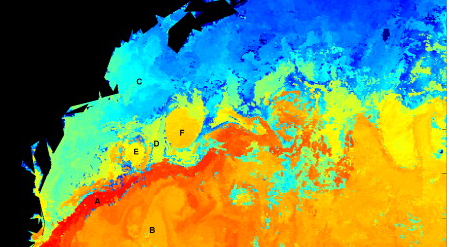
THE PICTURE ABOVE ISN’T some abstract expressionist art you might encounter in a Soho gallery. It’s a thermal image of a section of the North Atlantic (Credit: NASA JPL). The warm Gulf Stream [A] appears as a red-orange streak separating the warm Sargasso Sea [B] from the colder continental shelf [C]. Coldest water is bluest; warmest is deepest red.
Thermal imaging takes phenomena we’re generally familiar with and presents it in an arrestingly fresh way. In this case, depicting variation in temperature in a section of the world’s oceans. I’ve often wished for a tool like this that would show the degree to which things in the physical world have been overlaid with human ideas. By means of this make-believe technology things we’ve made heavy imaginative investments in over the centuries would glow fiery red, while other things would show cooler hues.
I’m convinced that wine would register as vivid scarlet on any such map. From the beginning we’ve embroidered its semantic fabric with meanings that go far beyond quenching thirst or getting buzzed. Raise a glass of wine and you lift not just a pleasantly alcoholic brew of fermented fruit juice, but a few millennia worth of meanings, associations, references, allusions, symbols. Heated by the human imagination, wine fairly glows.
An early example of wine as sign is provided by its reception in the great cities of the ancient Near East in the third millenium BCE. As an expensive import from the hill country far to the north, wine set its devotees apart from ordinary folk as wealthy and socially significant, likely with connections to the royal court. We know from art of the period that special tableware was associated with wine, and that a set of ritual gestures was de rigueur. Wine signifies power, affluence, privilege, and authority.
The Hebrew Bible made important contributions. Genesis tells us that it was the upright Noah who planted the first vineyard post-Deluge (though having indulged too freely in his debut vintage he behaved badly afterward ). The Song of Solomon links wine directly with the pleasures of lovemaking and sensuality in general. In the Law of Moses one of the marks of God’s special favor is said to be an abundance of “new wine and oil.” To judge from this, wine is also dangerous, sexy, and a sign you’re among the blessed.
Among the Greeks, wine and bread as elaborated rather than strictly natural products distinguished civilized, humane culture from mere animal life; while Bacchus, the boy-god of wine, took us out of ourselves and connected ordinary mortals with the divine and the ecstatic (dude rode a tiger!). Jesus turned water into wine at a wedding, and then turned wine into his blood in the ritual of the mass. Wine is both of this world and in touch with the transcendant.
Romans drank wine to set themselves apart from Germans who preferred beer. Conversely, Celts eager to affect Roman-ness and be judged worthy to launch a career in the service of empire gave up their beer and adopted wine. When it comes to constructing social identities, wine is prime building material.
The notion that wine is elite and sacred and beer proletarian and secular has been a persistent motif in Western culture and highlights the degree to which ideas represent a kind of currency, readily exchangeable and quick to accrue fresh values by means of the binary contrasts they create. Either ale is a manly drink and wine something for foofs and toffs; or wine is for sophisticates and ale for proles. Either way, there’s a shot of self-representation in every sip.
The signs we post with wine aren’t just for others. Sipping Cristal won’t make you a rock star any more than taking a glass of sherry with a biscuit at 4 in the afternoon will make you an Oxford don – but either can make you feel the part, if ever so briefly.
What a wonderfully fertile heap of cultural compost wine turns out to be! Centuries deep, whimsical and reasoned, sacred and profane, mostly coherent, occasionally inconsistent but endlessly useful – and still red hot after all these years.
Tasted this week
NV Breton “La Dillettante” Vouvray Brut. Pale, limpid amber. Quite fresh, outdoorsy aromas with savory – even saline – aspects. Palate is light-bodied with fine freshness, zip, and attractive minerality. Charming and versatile. $22
2011 Colterenzio Shreckbichl “Pfefferer” Dolomiti Moscato Giallo. Lovely, typical moscato aromatics with floral-lychee-lime elements. Palate is lime and melon and a base of solid, crisp, almost crunchy fruit and really stiff acids. Clean as a whistle finish. $17
2010 D’Angelo “Sacravite” Basilicata Aglianico. Deep, limpid mahogany. Nose of dusky black cherry fruit and scoops of loamy earth. Some black licorice notes and lightly raspy tannins. Chewy. Nicely firm acids. Lots of value. $15
2009 Ricci “San Martino” Colli Tortonesi. Rustic, slightly coarse impression but there’s abundant charm in the rich, sweet, dusty dark fruits that run deep and linger long. No shortage of acidity, either. A lovable bumpkin. $22
2011 Clos du Mont Olivet “Le Petit Mont” Chateauneuf du Pape. Bright, red berry aromas and flavors; some very nice earthy notes. Lightly scratchy texture and some appealingly firm acidity. Presents as elite-level Cotes du Rhone. Good, solid, satisfying stuff. $37
Reach me at stephenmeuse@icloud.com
Follow @stephen_meuse